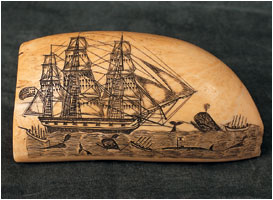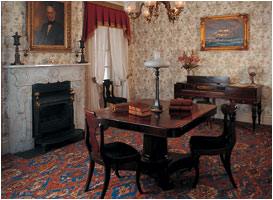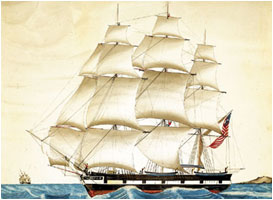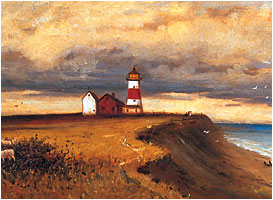|
 n the mid-eighteenth century, J. Hector St. John de Crevecoeur visited Nantucket during his tour of America. He was so impressed with the bustling little island that he included a full description of Nantucket in his 1780 book, Letters from an American Farmer. His surprise at finding an island “affording neither stones nor timber, meadows nor arable, yet can boast of an handsome town, consisting of more than 500 houses, should possess above 200 sail of vessels, constantly employ upwards of 2000 seamen, feed more than 15,000 sheep, 500 cows, 200 horses; and has several citizens worth £20,000 [pounds] sterling…” reflects how successful and prosperous Nantucket became in the first one hundred years of its English settlement. n the mid-eighteenth century, J. Hector St. John de Crevecoeur visited Nantucket during his tour of America. He was so impressed with the bustling little island that he included a full description of Nantucket in his 1780 book, Letters from an American Farmer. His surprise at finding an island “affording neither stones nor timber, meadows nor arable, yet can boast of an handsome town, consisting of more than 500 houses, should possess above 200 sail of vessels, constantly employ upwards of 2000 seamen, feed more than 15,000 sheep, 500 cows, 200 horses; and has several citizens worth £20,000 [pounds] sterling…” reflects how successful and prosperous Nantucket became in the first one hundred years of its English settlement.
|
 |
|
The Whaling Museum, built 1847, 13 Broad Street, Nantucket. Collection of the Nantucket Historical Association. Photograph by Carol Bates.
|
One popular Native American legend explains the formation of the island this way: one night the giant Maushop, who lived on the Atlantic Coast, and used Cape Cod for a bed, could not sleep. He tossed and turned until his moccasins were full of sand. This so angered him that he flung the moccasins from his feet with one landing to form Martha’s Vineyard and the other forming Nantucket.
In 1659, Thomas Mayhew and his son, who were deeded control of the island in 1641, sold it to nine men from the Merrimack Valley in northeastern Massachusetts. Known as the “proprietors,” these men included a Coffin, a Macy, a Hussey, and a Swain, names that resonate throughout the island’s history, even to the present day. Mayhew’s asking price for the island was thirty pounds sterling “and also two Beaver Hatts, one for myselfe, and one for my Wife.”
The first town on the island was established by European settlers around a natural harbor on the north shore and was called Sherburne. Unfortunately, that harbor silted up, requiring the houses, businesses, and people to move eastward, settling around the “Great Harbor,” still the harbor used today. In 1795 the town was named Nantucket, making it unique in this country with the island, the town, and the county all carrying the same name.
The initial group of European settlers expected to farm the land, much as they had in northeastern Massachusetts. However, the island’s sandy soil was easily depleted and as Obed Macy wrote in his 1835 History of Nantucket, “would not rate above a middling quality.” The original proprietors quickly turned their attention to raising livestock, rather than crops. Thus, stock raising became the island’s primary economic activity, long before the first sperm whale was harpooned. By 1704, the New England surveyor of customs listed Nantucket as one of the chief sheep- raising districts in the colonies.
In June each year, all of the animals needed to be sheared. To make this long, difficult job more enjoyable, islanders made shearing an annual celebration, lasting two or three days. Described as a “prolonged picnic,” the shearing festival offered food, drink, music, dancing, and social interaction for the community, while also accomplishing an enormous practical task. All other work stopped, with even the island’s newspaper reporting, “The orgies of the mutton- worshippers are beginning to burst forth, and all the woolly world is in an agony and a catastrophe of helter-skelterishness… consequence is, no paper next Saturday!”
In addition to farming and hunting small game, the natives and the European newcomers fished Nantucket’s shores, particularly for cod and shellfish. Small whales occasionally washed ashore and were prized for their oil, but by the 1690s, islanders began to organize expeditions in small boats, pursuing “right” whales, so called because they were of moderate size and slow moving, that passed close to Nantucket shores on annual migrations. Whale houses with elevated platforms were built along the south shore, and when the spouting whales were sighted, the boats set off to capture them. They were towed to shore and stripped of blubber, which would be “tried out” to extract the valuable oil.
 |
|
|
Scrimshaw whale tooth attributed to Edward Burdett (1805-1833), circa 1825. Collection of the Nantucket Historical Association. Photograph by Jeffrey S. Allen.
|
Deep-sea whaling began around 1715, a few years after the first sperm whale was taken by a sloop blown out to sea in a gale. Oil from the “head matter” of this gigantic creature was found to be of a quantity and quality unmatched by any natural or manmade product then available. However, the sperm whale lived in the deepest part of the world’s oceans, so Nantucketers began to make offshore voyages of fifty miles and more, but still needed to be within reach of shore to unload their catch and have it processed. By the mid-eighteenth century larger whaleships were built, becoming seagoing factories with all of the equipment needed to extract and store hundreds of barrels of oil. For the next one hundred years, Nantucket whaleships would travel the oceans of the world on their legendary three-, four-, and five-year voyages in search of “greasy luck” – a successful voyage with a full hold upon return home.
Nantucketers became renowned for their expertise in hunting sperm whales, turning a small island thirty miles off the coast of Massachusetts into a vibrant, sophisticated community. With much of the population involved in the whaling industry, Nantucket was far from isolated. Islanders traveled around the globe, opening whaling grounds in the South Pacific and Asia, and returning home with stories and souvenirs to share. For a century, from the mid-1700s to the 1830s, Nantucket was the whaling capital of the world. As Melville wrote in Moby-Dick, “Thus have these… Nantucketers… issuing from their anthill in the sea, overrun and conquered the watery world like so many Alexanders.”
Nantucket’s success in the whale fishery is well-documented, but was not without its ups and downs. While the American Revolution was rabidly supported by many Massachusetts residents, Nantucket’s Quaker pacifism and reliance on the British whale oil market meant that few islanders shared in that support. As the war raged on, pressure mounted on both sides for island residents to take a position. Island whaling voyages and trade with England were almost completely cut off and, by the end of the war, Nantucket’s fleet was in ruins.
The outcome of the war meant closure of the British whale-oil market, causing Nantucket to look for a new outlet for its primary export. Approximately twelve island families established a whaling outpost in Dunkirk, France, while others took advantage of the new opportunity to trade directly with other foreign countries and opened a trade route to China.
These measures enabled Nantucket to rebuild its economy. The island eventually regained leadership in the whaling industry, at least until the War of 1812, which caused the same pattern of economic depression and rebirth, but on a lesser scale, allowing the island to recover quickly and enter its most prosperous period in the 1820s.
As Nantucket’s men were sailing farther and farther around the globe, this seafaring lifestyle permitted Nantucket’s women to experience greater independence than their mainland counterparts. Many island wives and mothers supported themselves and their families by teaching school or running their own businesses. A section of Centre Street became known as “Petticoat Row” due to the number of female shopkeepers along that street. A poem titled “The Nantucket Girls Song” appears in the back of a journal kept by Eliza Brock on an 1853-1856 whaling voyage on the Lexington, helmed by her husband. Although we do not know who actually authored the poem, it expresses feelings that were common to many island women throughout the whaling era: I have made up my mind now to be a Sailor’s wife, To have a purse full of money and a very easy life, For a clever sailor husband is so seldom at his home, That his wife can spend the dollars with a will that’s all her own But when he says Goodbye my love, I’m off across the sea First I cry for his departure, then laugh because I’m free.
|
 |
|
Formal Parlor in the Hadwen House, 96 Main Street, Nantucket, built 1844. Collection of the Nantucket Historical Association.
|
Early nineteenth-century whaleships were equipped with smaller whaleboats, which were filled with a six-man crew and lowered to the water when a whale was sighted. After a quiet approach, the harpooner would stand in the bow of the boat aiming the iron harpoon at the whale, hoping for a direct hit. The harpoon did not kill the whale, but merely served the same function as a fishhook, attaching the whaleboat to the whale, by means of the rope “line” attached at either end to the harpoon and the whaleboat. As the whale dove, trying to free itself from the harpoon, the men and their whaleboat were taken on a “Nantucket sleigh ride,” often traveling miles from the mother ship at high rates of speed. Sometimes the whale would be successful in throwing the harpoon. If the men were successful, the whale would tire from the fight, rise to the surface, and put up little resistance to the deathblow, delivered with a lance. Then, the whale was towed back to the ship, where it could be “tried out” on board, a process of removing the valuable oil from the blubber.
Two of the Nantucket Historical Association’s properties are uniquely linked in a way that illustrates both the work of the whaling industry and the reward. The Nantucket Whaling Museum is a brick building originally constructed in 1847, and purchased by the firm of Hadwen and Barney in 1848, as a candle factory.When island whaleships returned home, loaded with their precious cargoes of oil, the barrels would be off-loaded and taken to one of the oil processing factories located around town. The Whaling Museum still contains one of the factory’s candle presses, which was used to process thousands of spermaceti candles that were then distributed around the world, giving “the clearest and most beautiful flame of any substance that is known in nature,” according to President John Adams.
 |
|
|
"Ship Alpha Passing St. Paul’s Isle Indian Ocean” attributed to George Marshall (1815-1860), 1846, watercolor and ink on paper, 16” H x 19” W. Collection of the Nantucket Historical Association.
|
William Hadwen, a successful silversmith from Rhode Island, came to Nantucket in 1820 to attend the wedding of his cousin Nathaniel Barney to Eliza Starbuck. Two years later, William married Eliza’s sister, Eunice, and the two couples shared a residence at 100 Main Street. William Hadwen and Nathaniel Barney deveoped a business relationship, owning property, businesses (like the candle factory), and whaleships, such as the ship Alpha. The Whaling Museum teaches many stories about the island’s whaling era on its own, but the Nantucket Historical Association is fortunate also to own William Hadwen’s home at 96 Main Street. The Greek Revival-style mansion, with white columns out front and a luxuriously decorated interior, illustrates the success of Nantucket’s whalers and merchants.
Throughout the island’s rise in prosperity, Nantucket’s political, economic, and religious leadership was dominated by the Religious Society of Friends, or Quakers. The Quaker faith was based on the tenets that the spirit of God exists in everyone and that individuals could worship God directly, without an intermediary. These beliefs engendered an independent spirit and a simple aesthetic that continued to shape island culture, even as the Society of Friends’ influence began to wane. Quaker leaders urged Friends to “keep out of the vain fashions of the world [and] keep all in modesty and plainness,” banning the ownership of colorful clothing and fancy household goods. However, as Nantucketers achieved financial success through the whale fishery, many used their wealth to pursue a more comfortable lifestyle, resulting in the weakening of the Society of Friends’ domination over island culture.
Unfortunately, Nantucket’s “palmy” days would not last. Several events came together, eventually bringing the once-great whaling port to its knees. In the 1830s, Pennsylvania’s petroleum fields began producing kerosene, a cheaper and more easily obtainable fuel source than whale oil. In 1846 a devastating fire, known as the “Great Fire,” reduced the downtown area to ashes in a matter of hours, leaving hundreds homeless and destitute. Ships were re-routed to the deeper harbor of New Bedford, which also offered access to mainland railroads. In 1849 gold was discovered in California and hundreds of unemployed Nantucket men traveled to the West Coast to try their luck in the mining camps. In 1869, the Oak became the last whaleship to depart Nantucket’s shores for the whaling grounds, bringing an end to what had been Nantucket’s “golden age of whaling.”
Between 1840 and 1870, the island’s population decreased from almost ten thousand people to little more than four thousand. With a depressed economy and many friends and families departing for mainland shores, life on Nantucket must have been bleak. But, the island would recover during the late-nineteenth century, when it became a popular vacation resort. As early as 1845, several large hotels were established and the local newspaper reported, “We see by the papers that Nantucket is becoming quite a fashionable place…and that a larger number than usual have resorted to the island the present season, in quest of health or pleasure.” By the 1870s, when noted artist Eastman Johnson took up summer residence on the island, Nantucket’s tourist trade was on the rise.
The island became especially popular with writers and artists given its relaxing atmosphere and ample subject matter. Engaging portraits of island characters and scenes of island life were often captured in charming genre paintings reflecting a sense of nostalgia in an increasingly industrialized nation. These same feelings affected the year-round Nantucket residents of the late-nineteenth century. Island residents relied upon the tourist trade for financial prosperity, but they also looked upon the seasonal visitors with suspicion, referring to them as “strangers.” One means of coping with the changes taking place on both national and local levels was to form a local historical society.
Formed in 1894 by a group of islanders, many still carrying the names of the original proprietors – Macy, Swain, Coffin, and Hussey, among others – the Nantucket Historical Association preserved ties to a seemingly simpler past, while also providing a touchstone for long-time residents. As the Association’s recording secretary, Mary Eliza Starbuck, wrote in her 1895 report to the membership, “Nantucket salt, truly, has not lost its savor; but the old pungency is somewhat abated by modern admixtures.”
|
 |
|
Sankaty Lighthouse by W. Ferdinand Macy (1852-1901), 1895, oil on canvas, 22 5/8” H x 45 1/2” W. Collection of the Nantucket Historical Association
|
The founders of the Association laid the groundwork for establishing a rich collection of artifacts, manuscripts, and historic structures that relate to each other and to Nantucketers of the past, present, and future. The twenty-five sites presently owned by the NHA span a wide spectrum of time and function from the Oldest House, a 1686 wedding gift for Jethro Coffin and Mary Gardner, whose marriage ended a family feud, to Greater Light, an eighteenth-century barn renovated into living space in 1930 by two Quaker sisters from Philadelphia, which helps illustrate the rebirth of the island as a vacation spot.
As the NHA enters the twenty-first century, it continues to collect, preserve, and educate, bringing Nantucket’s unique history to visitors from all over the globe, much as the eighteenth- and nineteenth-century whalers did. Noted whaling historian Edouard A. Stackpole, who was President of the NHA from 1938 to 1953 and from 1968 to 1971, expressed the importance of the Association when he wrote, “Our Nantucket museums are not primarily designed to remind us of events and people who lived on this island long, long ago; they have been created to present pictures of the past which may serve as guideposts for our world of the present and, certainly, for the future.”
Aimee E. Newell is Curator of Collections at the Nantucket Historical Association.
For further information on visiting the NHA Antiques Show, the Whaling Museum or the historic sites, please call (508)228-1894; or visit the website at www.nha.org
|